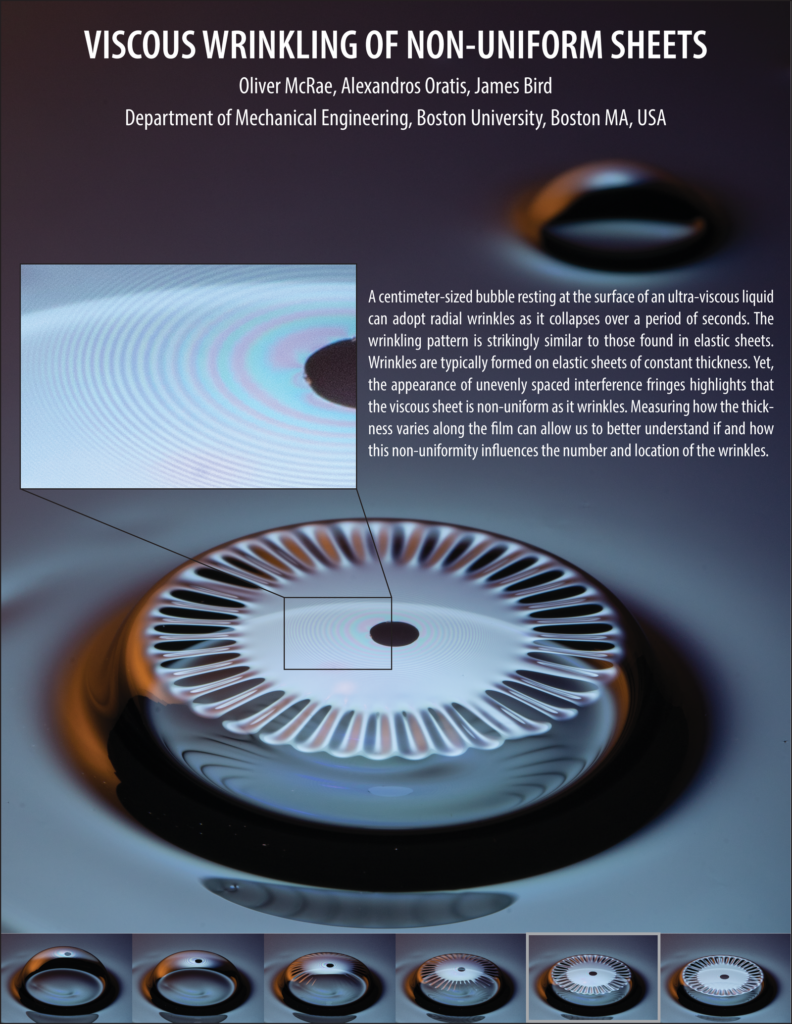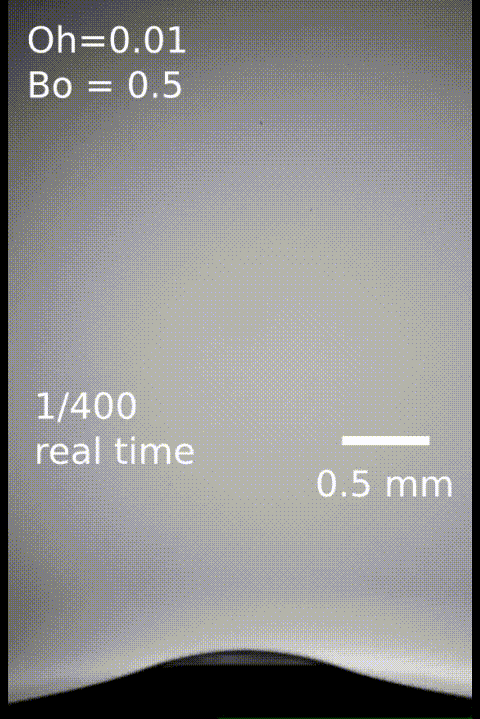APS Gallery of Fluid Motion
Viscous Wrinkling of Non-uniform Sheets2020 APS DFD Milton van Dyke Award Winner |
|
 |
A centimeter-sized bubble resting at the surface of an ultra-viscous liquid can adopt radial wrinkles as it collapses over a period of seconds. The wrinkling pattern is strikingly similar to those found in elastic sheets. Wrinkles are typically formed on elastic sheets of constant thickness. Yet, the appearance of unevenly spaced interference fringes highlights that the viscous sheet is non-uniform as it wrinkles. Measuring how the thickness varies along the film can allow us to better understand if and how this non-uniformity influences the number and location of the wrinkles. doi:10.1103/PhysRevFluids.6.110506 10.1103/APS.DFD.2020.GFM.P0027 |
Surfactant-free Bubble Stability in Volatile Liquids2018 APS DFD Gallery of Fluid Motion Award Winner |
|
| When a bubble arrives at a free surface, we typically expect the film of the bubble cap to thin over some period of time until it ruptures. Traditionally, the drainage of this film has been considered inevitable, and even the addition of surfactants cannot prevent its eventual rupture. Here we present air bubbles at the free surface of liquids which appear to defy traditional drainage rules and can avoid rupture, persisting for hours until dissolution. Using pure, volatile liquids free of any surfactants, we highlight and model a phenomenon in which liquid surrounding the bubble is continuously drawn into the bubble cap, effectively overpowering the drainage effects. | |
2-D Bubble Plumes |
|
| Bubbles injected under water beneath an inclined wall can spread out into a buoyant plume or rise single file, depending on the injection rate and wall angle. We vary these parameters and record high-speed videos of rising bubble streams and plumes, using image processing to map out the spreading angles and rise velocities. Understanding the dynamics of these 2D bubble plumes could help inform designs of aeration rigs being investigated for their potential for biofouling prevention in marine environments. | |
Capillary Displacement of Viscous Liquids |
|
| When a capillary tube is brought into contact with a wetting liquid, surface tension forces overcome gravity and the liquid spontaneously rises into the tube until an equilibrium height is reached. The early viscous dynamics of the rise typically follow the well-known Lucas–Washburn law, which is independent of gravity and neglects the displaced fluid. Here we explore the early viscous dynamics when the properties of displaced fluid are significant. Using a combination of experiments and theory, we show how the characteristic behavior of the Lucas–Washburn law is modified when the viscosity of the displaced fluid is comparable to or exceeds the wetting fluid. Additionally, we find that the effects of gravity reshape the dynamics of the capillary rise not only in the late viscous regime but also in the early viscous regime. http://pubsdc3.acs.org/doi/full/10.1021/acs.langmuir.6b00351 Article |  |
Jet Drops from Bursting Bubbles |
|
 |
When a bubble ruptures at a liquid surface the collapsing cavity produces a central jet that frequently breaks up into a series of droplets. Current experiment and theory predict that the production of jet drops will be limited by either viscous or gravitational effects. However, while there are a number of studies focusing on these two limiting cases, less is understood about the production of jet drops when both gravitational and viscous effects are significant. Here, we uncover the existence of an intermediate region where both gravitational and viscous effects play a critical role in jet-drop formation. We propose that the role of gravity is most important before rupture, and carry out simulations that demonstrate the importance of the equilibrium bubble shape in the production of jet drops. doi:10.1103/PhysRevE.92.021002 [PDF] |
Flapping Jets |
|
| We experiment with injecting a continuous stream of gas into a shallow liquid, similar to how one might blow into a straw placed at the bottom of a near-empty drink. By varying the angle of the straw (here a metal needle), we observe a variety of dynamics, which we film using a high-speed camera. Most noteworthy is an intermediate regime in which cyclical jets erupt from the air-liquid interface and breakup into air-born droplets. These droplets trace out a parabolic trajectory and bounce on the air-liquid interface before eventually coalescing. The shape of each jet, as well as the time between jets, is remarkably similar and leads to droplets with nearly identical trajectories. | |